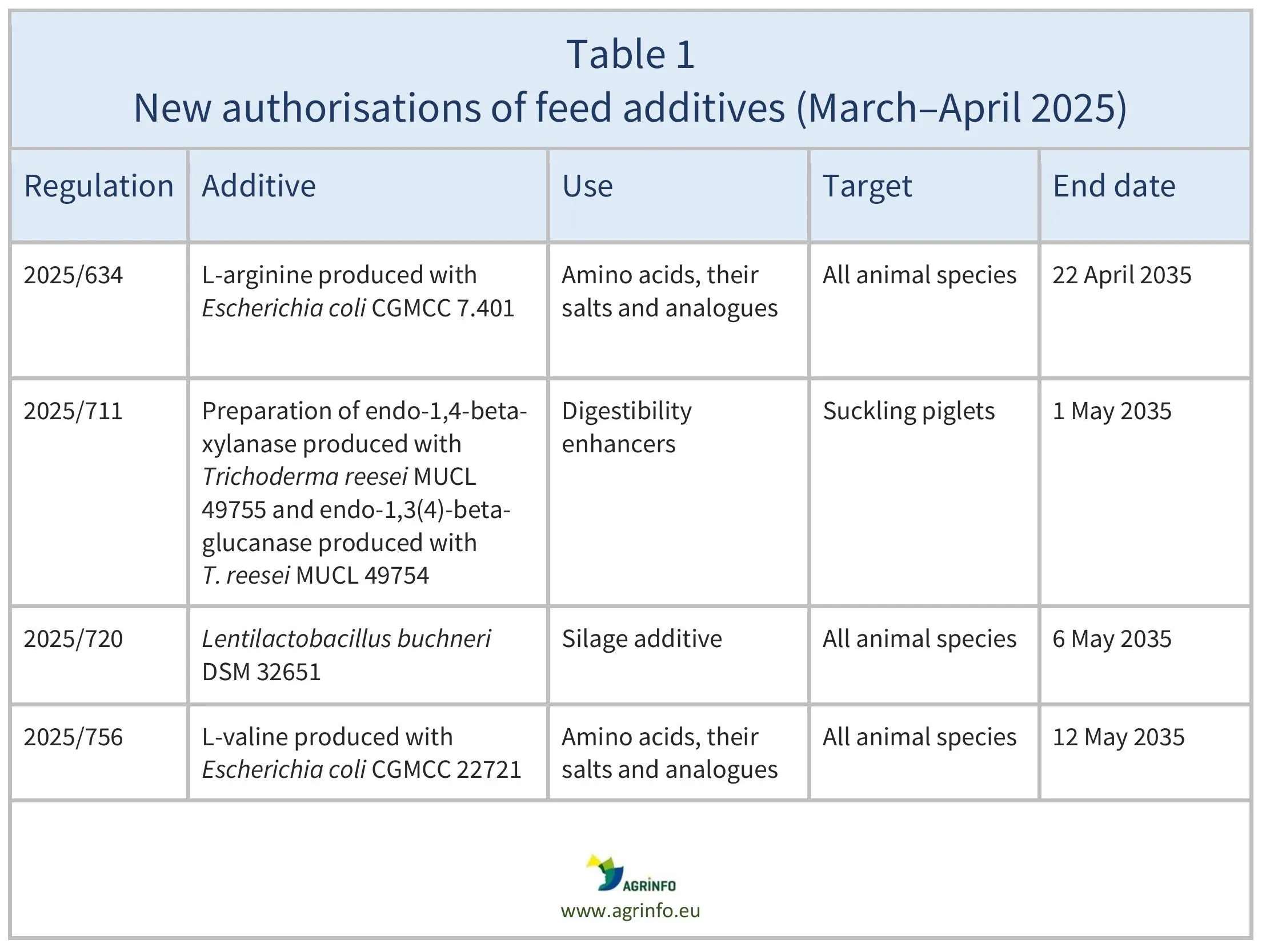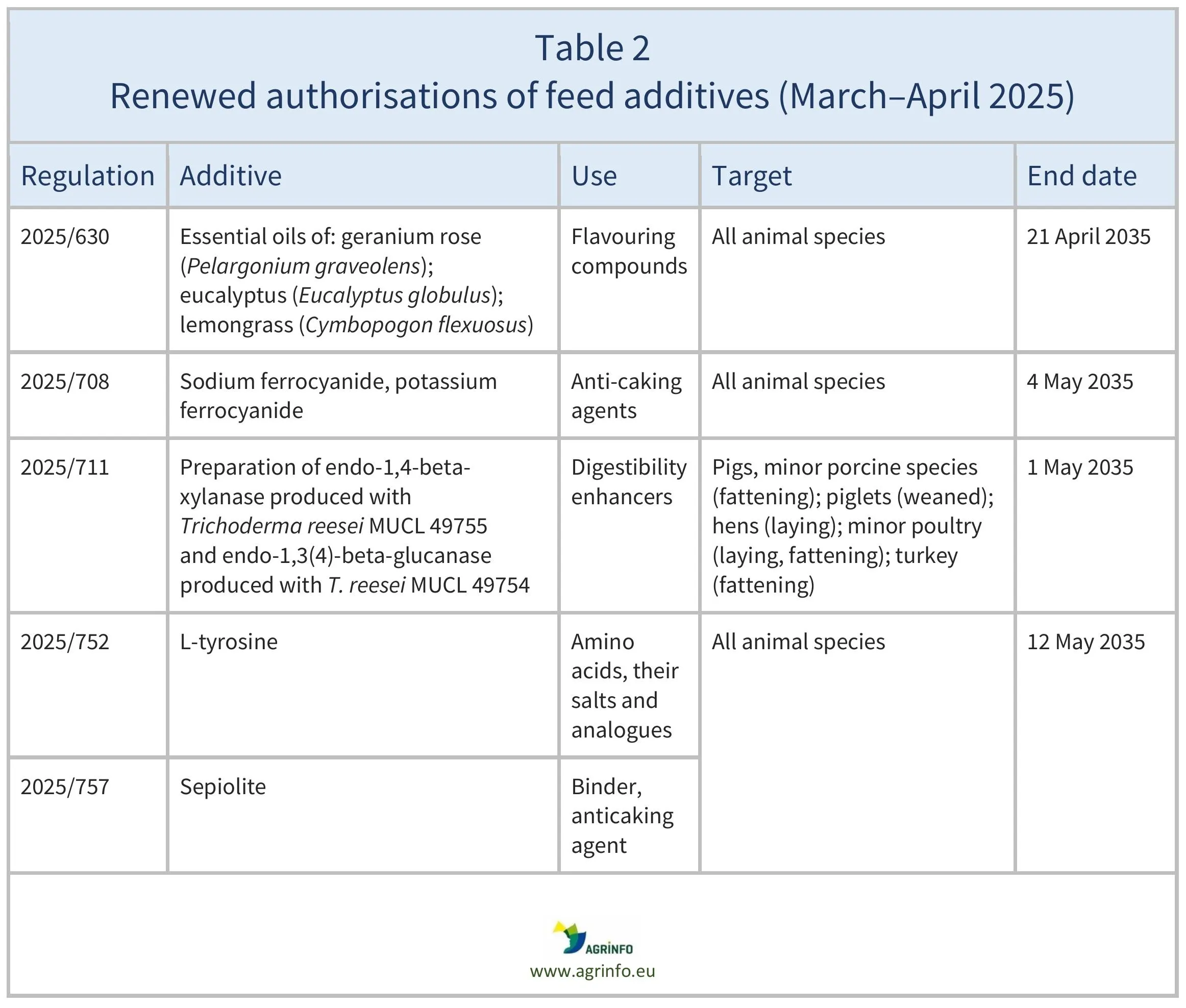Feed additives: March-April 2025 authorisations, reauthorisations, and corrections
- Feed additives
- Feed safety
Summary
Overview of the latest authorisations and reauthorisations of feed additives and their use in animal nutrition in target animals, and reintroduction of the method of analysis to determine carbonates in feed.
EU authorises/reauthorises certain feed additives and reintroduces analytical method to determine carbonates in feed
Commission Implementing Regulations 2025/630, 2025/634, 2025/708, 2025/711, 2025/720, 2025/752, 2025/756, 2025/757, 2025/782
Update
Overview of the latest authorisations and reauthorisations of feed additives and their use in animal nutrition in target animals, and reintroduction of the method of analysis to determine carbonates in feed.
Impacted Products
Feed additives, prepared fodder
What is changing?
Authorisations
In March–April 2025, the European Union (EU) authorised the feed additives listed in Table 1, based on opinions published by the European Food Safety Authority (EFSA) [see Resources 4, 7, 10, 12]. The conditions of use are described in the respective Regulations.
Reauthorisations
In March–April 2025, the EU reauthorised the feed additives listed in Table 2, based on opinions published by EFSA [see Resources 1–3, 5–9, 11]. The conditions of use are described in the respective Regulations.
Amendment regarding the determination of carbonates in feed
Regulation 2025/782 reintroduces the method of analysis to determine carbonates in feed.
Why?
Applications for the above authorisations and reauthorisations were submitted and considered by the Reference Laboratory set up by the Feed Additives Regulation (1831/2003).
The method for determining carbonates in feed was reintroduced because it is required to quantify carbonates in the authorised feed additive lanthanum carbonate octahydrate, and for the compulsory declaration of calcium carbonate for certain feed materials (Regulation 68/2013).
Timeline
The authorisations and reauthorisations remain valid until the end dates listed in Tables 1 and 2.
What are the major implications for exporting countries?
With these authorisations, more feed additives will be available on the market. Authorisations and renewals are valid for 10 years. The use of all preparations and substances specified as feed additives must comply with the provisions of use specified in the Annex to each Regulation.
Recommended Actions
Non-EU countries producing feed additives, compound feed, and feed materials for export to the European Union are recommended to check the status of the feed additives in the EU Feed Additives register.
To be able to filter and to see more information, it is advised to download the register in Excel format (see Food and Feed Information Portal).
Background
The procedure for authorising the placing on the market and use of feed additives is set out in Regulation 1831/2003.
Resources
EU Feed Additives register
Regulation 1831/2003 on additives for use in animal nutrition
- EFSA (2023) Safety and efficacy of a feed additive consisting of an essential oil from the herbaceous parts of Pelargonium graveolens L‘Hér. (geranium rose oil) for all animal species (FEFANA asbl). EFSA Journal, 21(7): e08161.
- EFSA (2023) Safety and efficacy of a feed additive consisting of an essential oil derived from Eucalyptus globulus Labill. (eucalyptus oil) for all animal species (FEFANA asbl). EFSA Journal, 21(7): e08178.
- EFSA (2023) Safety and efficacy of a feed additive consisting of an essential oil derived from the aerial parts of Cymbopogon flexuosus (Nees ex Steud.) Will. Watson (lemongrass oil) for use in all animal species (FEFANA asbl). EFSA Journal, 21(7): e08180.
- EFSA (2024) Safety and efficacy of a feed additive consisting of L-arginine produced with Escherichia coli CGMCC 7.401 for all animal species (Eppen Europe SAS). EFSA Journal, 22(10): e9028.
- EFSA (2023) Safety and efficacy of feed additives consisting of sodium ferrocyanide and potassium ferrocyanide for all animal species (Eusalt a.i.s.b.l.). EFSA Journal, 21(4): 7960.
- EFSA (2024) Safety and efficacy of a feed additive consisting of sodium ferrocyanide and potassium ferrocyanide for all animal species (Eusalt a.i.s.b.l.). EFSA Journal, 22(7): e8851.
- EFSA (2024) Assessment of the feed additive consisting of endo‐1,4‐beta‐xylanase (produced with Trichoderma reesei MUCL 49755) and endo‐1,3(4)‐beta‐glucanase (produced with T. reesei MUCL 49754) (AveMix® XG 10) for weaned piglets for the renewal of its authorisation and for its extension of use to suckling piglets (AVEVE BV). EFSA Journal, 22: e8852.
- EFSA (2024) Assessment of the feed additive consisting of endo‐1,4‐beta‐xylanase (produced with Trichoderma reesei MUCL 49755) and endo‐1,3(4)‐beta‐glucanase (produced with T. reesei MUCL 49754) (AveMix® XG 10) for laying hens and minor poultry species for fattening and laying for the renewal of its authorisation (AVEVE BV). EFSA Journal, 22: e8853.
- EFSA (2024) Assessment of the feed additive consisting of endo‐1,4‐beta‐xylanase (produced with Trichoderma reesei MUCL 49755) and endo‐1,3(4)‐beta‐glucanase (produced with T. reesei MUCL 49754) (AveMix® XG 10) for pigs for fattening, minor porcine species for fattening and turkeys for fattening for the renewal of its authorisation (AVEVE BV). EFSA Journal, 22: e8951.
- EFSA (2024) Safety and efficacy of a feed additive consisting of Lentilactobacillus buchneri DSM 32651 for all animal species (BioCC OÜ). EFSA Journal, 22(10): e9029.
- EFSA (2024) Assessment of the feed additive consisting of L-tyrosine for all animal species for the renewal of its authorisation (BCF Life Sciences). EFSA Journal, 22(7): e8845.
- EFSA (2024) Safety and efficacy of a feed additive consisting of L-valine produced with Escherichia coli CGMCC 22721 for all animal species (Eppen Europe SAS). EFSA Journal, 22(10): e9024.
Sources
Disclaimer: Under no circumstances shall COLEAD be liable for any loss, damage, liability or expense incurred or suffered that is claimed to have resulted from the use of information available on this website or any link to external sites. The use of the website is at the user’s sole risk and responsibility. This information platform was created and maintained with the financial support of the European Union. Its contents do not, however, reflect the views of the European Union.
EU authorises/reauthorises certain feed additives and reintroduces analytical method to determine carbonates in feed
Commission Implementing Regulations 2025/630, 2025/634, 2025/708, 2025/711, 2025/720, 2025/752, 2025/756, 2025/757, 2025/782
What is changing and why?
In March and April 2025, the European Union (EU) authorised or reauthorised the feed additives listed in Tables 1 and 2. These authorisations are based on opinions published by the European Food Safety Authority (EFSA). The conditions of use are described in the respective Regulations.
The EU has also reintroduced a method of analysis to determine carbonates in feed.
Actions
Countries outside the EU that produce feed additives, compound feed, and feed materials for export to the European Union should check the status of feed additives in the EU Feed Additives register.
To be able to filter and see more information, it is advised to download the register in Excel format (see Food and Feed Information Portal).
Timeline
The authorisations and reauthorisations remain valid until the end dates listed in Tables 1 and 2.
Tables & Figures
Disclaimer: Under no circumstances shall COLEAD be liable for any loss, damage, liability or expense incurred or suffered that is claimed to have resulted from the use of information available on this website or any link to external sites. The use of the website is at the user’s sole risk and responsibility. This information platform was created and maintained with the financial support of the European Union. Its contents do not, however, reflect the views of the European Union.


